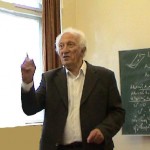On the occasion of his 85th birthday and 65 years of scientific activity.

One of the great contemporary geometers, Professor, Dr. Maks Aizikovich
Akivis celebrated his 85th birthday and 65 years of scientific activity on January 5, 2008. On this occasion we want to honor the continuing scholarly productivity of Akivis whose scientific activity prior to 1993 and through 1998 was recognized in articles Maks Aizikovich Akivis published in Uspekhi Mat. Nauk 48 (1993), no. 3 (291), 213–216; in Webs and Quasigroups, 1993, pp. 4–8; and in Webs and Quasigroups, 1998/1999, pp. 7–11. In the last publication, a complete list of Akivis’ publications prior to 1999 and the list of Ph. D. theses written under his supervision were published.
Maks Aizikovich Akivis was born on January 5, 1923 in Novosibirsk, USSR.
While he was in high school, he demonstrated outstanding mathematical talent and ability. In 1940 he entered the Faculty of Mechanics and Mathematics of Moscow State University. During the Great Patriotic War (WWII) his studies were interrupted from 1942 to 1945 while he served in the Soviet Army and participated in the liberation of Prague and the capture of Berlin. For his patriotic service he was awarded many orders and medals.
After WWII he resumed his studies at Moscow State University. However,
he was not able to graduate normally: he was expelled when he was a fifth
year student for “ideological reasons”. These “ideological reasons” also kept
Akivis, one of the best students of the Faculty of Mechanics and Mathematics,
from becoming a graduate student of Moscow State University. Not until 1958 was he able to defend his Ph. D. thesis which summarized the results of his undergraduate work. In 1964 Akivis defended a second (Doctor of Science) dissertation, and one year later, in 1965 he became a full professor.
Professor I. M. Gelfand, who taught at Moscow State University in the 1940s,
recalls: “M. A. Akivis and E. B. Dynkin were my best students at Moscow
State University in the 1940s. Akivis choose Differential Geometry as his field
of research. Unfortunately, the end of his career as a student was darkened
by the conditions in the Soviet Union at that time, and he could not pursue
the normal graduate studies. However, he was able to overcome all difficulties and became one of the best scientists of his generation in the area of classical differential geometry.”
From 1956 to 1960 Akivis taught at the Tula Mechanical Institute, and from
1960 to 1994 he was a Professor in the Department of Mathematics at Moscow Institute of Steel and Alloys.
Since 1948 Akivis published more than 150 scientific books and papers. His results in multidimensional projective and conformal differential geometry, in web theory and in the theory of differential geometric structures are fundamental. Many of these results are classical and are cited in numerous papers.
The first Akivis papers were devoted to the T-pairs of complexes (three-parameter families) of straight lines in a three-dimensional projective space.
His advisor S. P. Finikov suggested that he apply the notion of harmonic intersection of ruled surfaces which had been introduced by E. Cartan to the theory of congruences (two-parameter families) of straight lines of a three-dimensional projective space. Akivis solved this problem brilliantly: he found a new geometric property of the T-pairs of congruences introduced by Finikov and extended his results to the pairs of complexes of straight lines. As he showed, the T-pairs of complexes of straight lines he discovered are transferred by the Plücker mapping into a configuration of a five-dimensional projective space consisting of a tangentially degenerate two-dimensional submanifold and a three-dimensional submanifold carrying a net of conjugate lines. In the 1950s and 1960s Akivis devoted a series of papers to the projective theory of submanifolds of the type indicated above. As a result, he created a new area of projective differential geometry which continues to be developed successfully to this day.